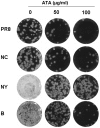Aurintricarboxylic acid is a potent inhibitor of influenza A and B virus neuraminidases
- PMID: 20020057
- PMCID: PMC2792043
- DOI: 10.1371/journal.pone.0008350
Aurintricarboxylic acid is a potent inhibitor of influenza A and B virus neuraminidases
Erratum in
- PLoS One. 2013;8(6). doi: 10.1371/annotation/eb17187c-4618-4558-89e4-322d4acc9b04
Abstract
Background: Influenza viruses cause serious infections that can be prevented or treated using vaccines or antiviral agents, respectively. While vaccines are effective, they have a number of limitations, and influenza strains resistant to currently available anti-influenza drugs are increasingly isolated. This necessitates the exploration of novel anti-influenza therapies.
Methodology/principal findings: We investigated the potential of aurintricarboxylic acid (ATA), a potent inhibitor of nucleic acid processing enzymes, to protect Madin-Darby canine kidney cells from influenza infection. We found, by neutral red assay, that ATA was protective, and by RT-PCR and ELISA, respectively, confirmed that ATA reduced viral replication and release. Furthermore, while pre-treating cells with ATA failed to inhibit viral replication, pre-incubation of virus with ATA effectively reduced viral titers, suggesting that ATA may elicit its inhibitory effects by directly interacting with the virus. Electron microscopy revealed that ATA induced viral aggregation at the cell surface, prompting us to determine if ATA could inhibit neuraminidase. ATA was found to compromise the activities of virus-derived and recombinant neuraminidase. Moreover, an oseltamivir-resistant H1N1 strain with H274Y was also found to be sensitive to ATA. Finally, we observed additive protective value when infected cells were simultaneously treated with ATA and amantadine hydrochloride, an anti-influenza drug that inhibits M2-ion channels of influenza A virus.
Conclusions/significance: Collectively, these data suggest that ATA is a potent anti-influenza agent by directly inhibiting the neuraminidase and could be a more effective antiviral compound when used in combination with amantadine hydrochloride.
Conflict of interest statement
Figures










Similar articles
-
Neuraminidase inhibitor susceptibility and neuraminidase enzyme kinetics of human influenza A and B viruses circulating in Thailand in 2010-2015.PLoS One. 2018 Jan 11;13(1):e0190877. doi: 10.1371/journal.pone.0190877. eCollection 2018. PLoS One. 2018. PMID: 29324781 Free PMC article.
-
Aurintricarboxylic acid inhibits influenza virus neuraminidase.Antiviral Res. 2009 Feb;81(2):123-31. doi: 10.1016/j.antiviral.2008.10.006. Epub 2008 Nov 17. Antiviral Res. 2009. PMID: 19014974 Free PMC article.
-
Influenza A viruses of swine circulating in the United States during 2009-2014 are susceptible to neuraminidase inhibitors but show lineage-dependent resistance to adamantanes.Antiviral Res. 2015 May;117:10-9. doi: 10.1016/j.antiviral.2015.02.004. Epub 2015 Feb 19. Antiviral Res. 2015. PMID: 25701593 Free PMC article.
-
Influenza virus susceptibility and resistance to oseltamivir.Antivir Ther. 2007;12(4 Pt B):603-16. Antivir Ther. 2007. PMID: 17944268 Review.
-
[Drug-resistant influenza viruses: an overview].Nihon Rinsho. 2010 Sep;68(9):1671-8. Nihon Rinsho. 2010. PMID: 20845746 Review. Japanese.
Cited by
-
The plasma membrane calcium ATPase 4 signalling in cardiac fibroblasts mediates cardiomyocyte hypertrophy.Nat Commun. 2016 Mar 29;7:11074. doi: 10.1038/ncomms11074. Nat Commun. 2016. PMID: 27020607 Free PMC article.
-
A Fluorescence Polarization-Based High-Throughput Screen to Identify the First Small-Molecule Modulators of the Human Adenylyltransferase HYPE/FICD.Int J Mol Sci. 2020 Sep 27;21(19):7128. doi: 10.3390/ijms21197128. Int J Mol Sci. 2020. PMID: 32992526 Free PMC article.
-
Antiviral activity of mycosynthesized silver nanoparticles against herpes simplex virus and human parainfluenza virus type 3.Int J Nanomedicine. 2013;8:4303-14. doi: 10.2147/IJN.S50070. Epub 2013 Nov 6. Int J Nanomedicine. 2013. PMID: 24235828 Free PMC article.
-
Drug Repurposing for Therapeutic Discovery against Human Metapneumovirus Infection.Antimicrob Agents Chemother. 2022 Oct 18;66(10):e0100822. doi: 10.1128/aac.01008-22. Epub 2022 Sep 12. Antimicrob Agents Chemother. 2022. PMID: 36094205 Free PMC article.
-
Treatment with specific and pan-plasma membrane calcium ATPase (PMCA) inhibitors reduces malaria parasite growth in vitro and in vivo.Malar J. 2022 Jun 29;21(1):206. doi: 10.1186/s12936-022-04228-0. Malar J. 2022. PMID: 35768835 Free PMC article.
References
-
- Carrat F, Flahault A. Influenza vaccine: the challenge of antigenic drift. Vaccine. 2007;25:6852–6862. - PubMed
-
- Hannoun C, Megas F, Piercy J. Immunogenicity and protective efficacy of influenza vaccination. Virus Res. 2004;103:133–138. - PubMed
-
- Puthavathana P, Auewarakul P, Charoenying PC, Sangsiriwut K, Pooruk P, et al. Molecular characterization of the complete genome of human influenza H5N1 virus isolates from Thailand. J Gen Virol. 2005;86:423–433. - PubMed
-
- Novel Swine-Origin Influenza A (H1N1) Virus Investigation Team. Emergence of a Novel Swine-Origin Influenza A (H1N1) Virus in Humans. N Engl J Med. 2009;360:2605–2615. - PubMed
-
- Ludwig S, Planz O, Pleschka S, Wolff T. Influenza-virus-induced signaling cascades: targets for antiviral therapy? Trends Mol Med. 2003;9:46–52. - PubMed
Publication types
MeSH terms
Substances
LinkOut - more resources
Full Text Sources
Other Literature Sources
Research Materials

